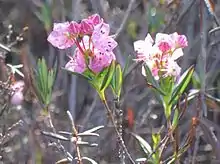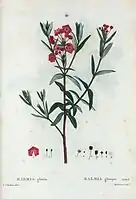Kalmia polifolia
Kalmia polifolia, previously known as Kalmia glauca[1] and commonly called bog laurel, swamp laurel,[2] or pale laurel, is a perennial[3] evergreen shrub of cold acidic bogs, in the family Ericaceae. It is native to north-eastern North America, from Newfoundland to Hudson Bay southwards.
| Kalmia polifolia | |
|---|---|
 | |
| Scientific classification | |
| Kingdom: | Plantae |
| Clade: | Tracheophytes |
| Clade: | Angiosperms |
| Clade: | Eudicots |
| Clade: | Asterids |
| Order: | Ericales |
| Family: | Ericaceae |
| Genus: | Kalmia |
| Species: | K. polifolia |
| Binomial name | |
| Kalmia polifolia | |
| Synonyms[1] Chamaedaphne glauca | |
|
Kalmia glauca | |
Etymology
The genus 'Kalmia' is named after Pehr Kalm, a Swedish-Finn botanist, who was a student of Linnaeus. The species name, 'polifolia', is Latin for 'pole-leaves' or 'pole-petals'.
The former species name, 'glauca', is Latin for gleaming or gray, a word ultimately derived from the Ancient Greek 'γλαυκός', meaning blue-green or blue-gray.
History
The plant was first described by Friedrich Adam Julius von Wangenheim, a German botantist.
Environment
Kalmia polifolia is common throughout Northern North American,[1] thriving along the Eastern American states and in Montana, as well as in every Canadian province except in British Columbia,[3] although spottings have been reported of Kalmia polifolia at Rhododenron Lake, located near Vancouver Island.[4][5] Within Canada, Kalmia polifolia is very commonly found in east Nova Scotia where bog conditions are more frequent.[6] Kalmia polifolia has also been spotted in a bog in Surrey, England.[1]
Description
—John A. Murray, The Mountain Reader[7]
Kalmia polifolia flowers in April and is pollinated by bees.[1] Bees, however, after pollinating this plant, produce a poison honey.[8] Its seeds ripen in September.[1] These seeds are five-parted, round, and woody.[9]
Kalmia polifolia can grow to be two feet tall. Its leaves are arranged oppositely upon its branch and grow to be an inch to an inch and a half in length and tend to be waxy with an entire and revolute margin.[9] Below each leaf base there are ridges, where it appears as though a part of the leaf is curled around the circumference of the stem. This is especially noticeable lower on the plant.
The base of the petiole is pressed against the stem as its flowers cluster in a single terminal bunch, which appears to be pink or purple in colour; the near cup-shaped flower spans about three-eighths of an inch in diameter.[9]
Uses
_(23945002063).jpg.webp)
As medicine
Kalmia polifolia can be used topically for skin wounds, disease, and inflammation, while internal uses may address bleeding and diarrhoea.[1]
As poison
Every part of Kalmia polifolia is highly toxic and poisonous to animals and persons.[8] Although related to Kalmia angustifolia (lambkill), it is less toxic.
Certain indigenous groups have used the toxicity of the plant's leaves to commit suicide.[1]
According to Alaback et al., Kalmia polifolia contains a grayanotoxin, which when ingested lowers blood pressure, and may cause respiratory problems, dizziness, vomiting, or diarrhea.[10] According to Lewis and Elvin-Lewis, the active compounds within Kalmia polifolia include andromedotoxin and arbutin. These compounds cause a slowing of pulse, a lowering of blood pressure, progressive paralysis and death.[11] Kalmia polifolia has poisoned cattle, goats and sheep. For poisoning to occur, the animal must consume 0.3% of its body weight, while a dosage of 2% of an would cause severe sickness.[8]
Symptoms for affected goats include depression, nausea, salivation, vomiting, and grating of teeth.[8]
Symptoms for affected sheep include depression, staggering, nausea, recubency, salivation, and vomiting.[8]
Gallery
.jpg.webp)
_(24276279950).jpg.webp)

.jpg.webp)
.png.webp) Kalmia polifolia (1792)
Kalmia polifolia (1792) Kalmia glauca, by Pierre-Joseph Redouté (1759-1840)
Kalmia glauca, by Pierre-Joseph Redouté (1759-1840) Kalmia polifolia, by Mary Vaux Walcott (1860-1940)
Kalmia polifolia, by Mary Vaux Walcott (1860-1940)
References
- "Kalmia polifolia Swamp Laurel, Bog laurel PFAF Plant Database".
- "Kalmia polifolia". Germplasm Resources Information Network (GRIN). Agricultural Research Service (ARS), United States Department of Agriculture (USDA). Retrieved 10 January 2018.
- "Plants Profile for Kalmia polifolia (bog laurel)".
- "Rhododendron Lake - Nanaimo Rhododendron Society".
- http://scholar.lib.vt.edu/ejournals/JARS/v39n4/v39n4-hodgson.htm
- Roland, A. E., Smith, E. C.. 2007. The Flora of Nova Scotia. Nova Scotian Institute of Science.
- Murray, John A. (1 July 2000). The Mountain Reader. Globe Pequot. ISBN 9781585740222 – via Google Books.
- "Canadian Poisonous Plants Information System - Kalmia polifolia (Scientific name)". 2014-04-10.
- "Kalmia polifolia Fact Sheet".
- Paul Alaback, Joe Antos, Trevor Goward, Ken Lertzman, Andy MacKinnon, Jim Pojar, Rosamund Pojar, Andrew Reed, Nancy Turner, Dale Vitt (2004). Jim Pojar and Andy MacKinnon (ed.). Plants of the Pacific Northwest Coast (Revised ed.). Vancouver: Lone Pine Publishing. p. 53. ISBN 978-1-55105-530-5.CS1 maint: multiple names: authors list (link)
- Lewis, Walter H.; Elvin-Lewis, Memory P. F. (4 September 2003). Medical Botany: Plants Affecting Human Health. John Wiley & Sons. ISBN 9780471628828 – via Google Books.
- Bergerud, Arthur T. (1 January 1972). "Food Habits of Newfoundland Caribou". The Journal of Wildlife Management. 36 (3): 913–923. doi:10.2307/3799448. JSTOR 3799448.
- "Horticultural challenges in the First Nations Garden".
External links
 Media related to Kalmia polifolia at Wikimedia Commons
Media related to Kalmia polifolia at Wikimedia Commons- USDA Plants Profile for Kalmia polifolia
- Jepson Manual Treatment
- UC CalPhotos gallery of Kalmia polifolia